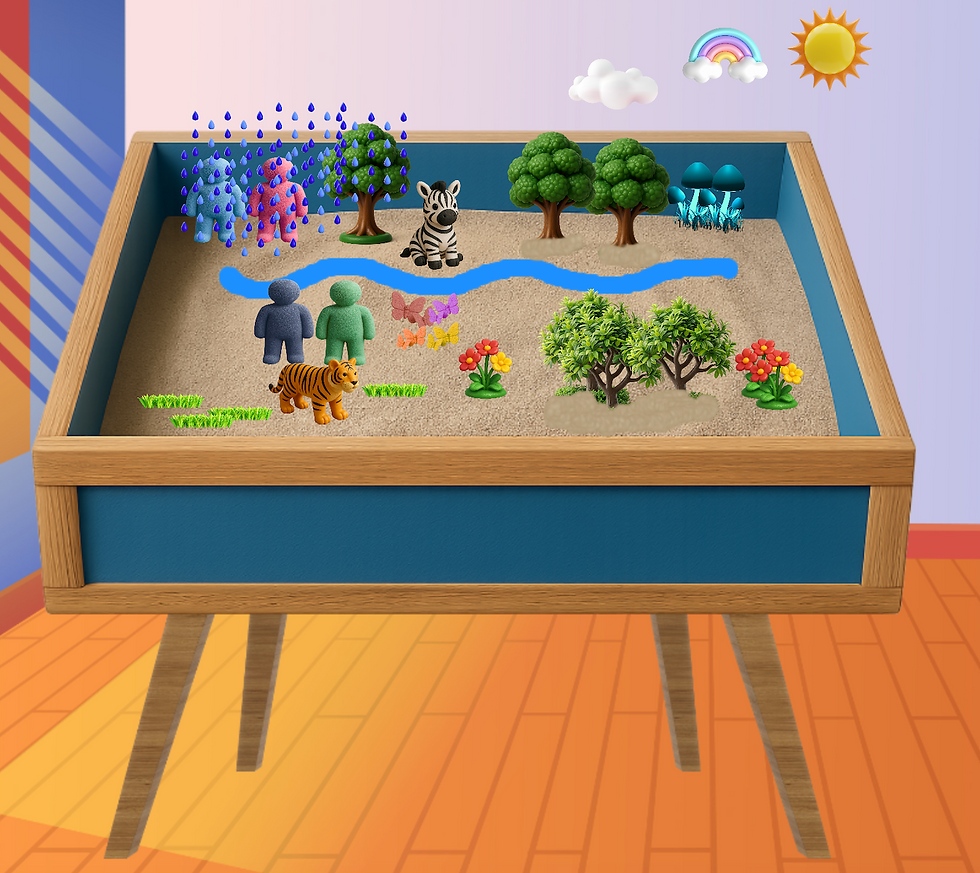11 Lively DBT Tools for Groups, Therapy, and Self-Help
- Jennie Lannette Bedsworth, MSW, LCSW

- May 6, 2024
- 7 min read
Updated: Apr 18
Download games, worksheets, and more DBT tools for your sessions and skills groups.
The first time I observed a DBT skills group the whole thing was a bit overwhelming to me. The mindfulness and skills made sense, but it seemed like a lot to keep track of. Plus there are individual sessions and diary cards?
As it turns out, there is indeed quite a bit to DBT (dialectical behavioral therapy) but the variety of strategies included really work for many people, often when nothing else has. Over time the skills become more familiar and mindfulness second-nature.
If you’re a group leader new to DBT, or you’re a veteran who feels like you’ve heard it all before, you might be looking for more resources. Here are 10 terrific DBT tools you can use to review skills, run groups, or learn something new.
1. DBT Jeopardy Therapy Games

Check out this new DBT skills game bundle that includes 4 separate games, covering the core skills areas of:
Emotional Regulation
Distress Tolerance
Mindfulness
Interpersonal Effectiveness
Although not an official Jeopardy-game this quiz show has a familiar format with clever categories filled with discussion prompts to encourage open communication. It's ideal for teen and adults DBT skill groups. There are no wrong answers, just meaningful prompts to encourage participation and engagement. Groups familiar with DBT will find it rewarding, while players new to the skills will learn plenty along the way.
2. The Greatest DBT Game on Earth
This fun and creative DBT tool includes dozens of prompts that are discussed as you move around the board. It’s a printable game designed around a carnival theme, with features such as the mindfulness tent, emotional roller coaster, Ferris wheel of distress, and the interpersonal advisor.
Each category represents the types of skills in DBT.
Questions vary in difficulty, and the game is probably most helpful for a group with some familiarity with popular DBT skills. However, you can customize the questions to what works best for you.
Here are some example prompts directly from the game:
What's one thing that might make it difficult to deal with an emotion?
What's an example of an event that led to you feeling angry?
Give an example of an emotional myth (incorrect belief about emotions)
Name one part of the ACCEPTS skill and give an example to go with it.
What is One-Mindfully? Give an example.
The great thing is that you can review the prompts and remove the ones you haven’t covered yet, or add in your own! You can also include some of your new skills and use them as teachable moments when they come up in the game.
2. DBT Wise Mind Tool
Wise Mind is one of the core skills you’ll learn in DBT. However it’s a bit of an abstract concept and it can be hard to teach. It’s even harder to get it into a written form, but I think the Wise Mind Skills Worksheet does a great job.
The worksheet begins with the venn diagram often used to show where the more responsible and the more impulsive parts of your mind overlap. In that area there is an opportunity for balance, where you can make the best decisions for your life now and in the future.
The following pages of the worksheet include a visual and journaling activity to help brainstorm and better understand yourself and your wise mind. Check out the DBT skills worksheet and download it here.
3. DBT Jenga Sticker Prompts
Would you rather stare at a group leader and answer questions, or play a game of Jenga while drawing discussion prompts? I know what I would answer!
The Jenga prompt stickers are a fun DBT tool that allows you to make discussion and skills review fun.
To play them as a Jenga game, print out the stickers on sticky paper or use tape to attach them to your separately purchased Jenga blocks. As a block is removed, the player must answer the prompt before placing it back on the stack.
Alternatively, you can just put the Jenga blocks into a bag to draw from, or draw from the prompts on strips of paper. Use your imagination and the prompts however you like! Here are some example DBT discussion questions from the game:
How can you be gentle when communicating with someone? Why would you be gentle?
Give an example of using taste to be mindful. Include details and describe the experience.
Some people use exercise as a way to feel better. Does it work for you? Why or why not?
What does it mean to cope ahead? Give an example of how you could use it.
Sound fun?
4. DBT DEARMAN Worksheet
DEARMAN is a DBT tool that’s used to help people learn to assert themselves to voice boundaries or ask for something they need. For example, you might ask that an intrusive coworker not interrupt you throughout the day, or even ask your roommate to agree to get a new puppy together.
This DBT DEARMAN worksheet includes the typical outline showing what the full acronym stands for. However, it also includes space to brainstorm, visualize, and review how the skill might actually work in the moment.
If you’ve reviewed DEARMAN with the usual worksheet(s) dozens of times already, this might be a good way to go over the skill in a familiar but fresh way.
5. DBT Printable Dice
The printable DBT dice are similar to the Jenga prompt stickers, but in a rollable dice format. Print and assemble the dice, and then use them to roll out prompts or skills such as the WHAT or problem-solving skill.
In one activity included, you can roll out a prompt and skill together. For example, one set of dice includes an instruction such as “Give an example of using the skill.” Meanwhile, the second dice rolled has skills listed such as the pros/cons skill.
The player might then describe how they would use the pros-cons skill to decide whether to ask someone on a date, or if they should have the last piece of cake. The DBT dice are a playful tool you can use to add some variety and fun to a DBT skills group, or even to review skills for yourself.
6. Radical Acceptance DBT Worksheet
Radical acceptance is another DBT tool that is difficult to put into words. That’s because it’s an abstract, almost spiritual concept. It’s the idea that when something happens that you cannot change or control, it’s sometimes best to just accept it as it is. Admittedly, that’s easier said than done.
The radical acceptance worksheet is one DBT tool you can use to practice the concept. The worksheet takes a unique approach by providing examples of how radical acceptance might work cognitively.
Here’s one example the worksheet walks through:
Situation: Someone backed into your car and now it’s undriveable, and your work is across town.
Skill: Applying DBT Radical Acceptance
Internal Thought: This car situation is going to be a nightmare. But there’s no way to reverse an accident so it is what it is.
Result: Accepting the situation and moving forward rather than ruminating on what’s already happened.
While radical acceptance is more of an internal decision, thinking through the situation can help you get to that place. You can use it in immediate situations like the car accident, or bigger issues such as dealing with a chronic illness.
The DBT Radical Acceptance worksheet can help you practice situations where the tool might be helpful.
7. FEELOPOLY Emotions Validation Game
FEELOPOLY is a printable therapeutic board game designed to help people understand and validate their emotions. While it doesn’t specifically reference DBT or DBT skills, it is consistent with the emotional validation elements of the therapy. It can be a great tool for individual therapy or groups.
In the game, players navigate a board featuring various emotions and scenarios, drawing cards that prompt discussions and activities related to various feelings. A team works together to locate, name, and validate emotions on the board. Once all emotions are validated the team wins together in a cooperative effort.
FEELOPOLY is one of the most popular and available therapy games because it’s printable, unique yet familiar, and can be a great break from the usual group activities. Learn more.
8. Emotions Wheel Tool
Do you or does your group struggle with recognizing emotions and the physical sensations that go with them? This unique emotions wheel includes the traditional feeling categories, but goes a step further by identifying emotional sensations.
It can be a great grounding and even mindfulness tool for DBT groups.
In addition to the emotions wheel itself, there is a worksheet that allows you to fill in your own feelings, physical sensations, and skills to use when needed to regulate the emotion.
An effective way to bring DBT to the activity is to use DBT skills in the coping section of the wheel. Discuss as a group possible strategies to deal with overwhelming feelings like anger, sadness, or discouragement.
9. Coping Skills Jeopardy-Style Game
The coping skills quiz show is another activity that’s not specifically created for DBT, but does have some nice overlap in skills such as using mindfulness and setting boundaries. It would be fairly natural to apply DBT strategies and tools to the game.
The game is set up in PowerPoint and has animation features similar to a real Jeopardy game, which makes it quite a fun break from the usual therapy activities. If you have the ability to use PowerPoint and project it in a classroom or group setting (or even Zoom) it would be an ideal game.
This particular version is created for teens and adults, however there’s another game that’s more appropriate for kids (although it is also used for all ages).
10. Grounding Stone Activity
I probably first used the grounding stone activity in a DBT group, although I can’t quite remember. However, it’s definitely my favorite mindfulness activity and would make a great DBT group tool.
You begin by choosing and holding a stone or other small object and bringing your awareness to it. You then follow a series of mindfulness prompts which will associate the stone with a sense of relaxation. From there you can use the stone and activity anytime you like on your own!
I’ve created a worksheet and kit that you can use alongside the basic activity and it makes a great tool for DBT groups. Learn more and download it here.
This is just a short list of DBT tools you might use, however I hope it’s a unique one. There are the typical books and worksheets often used, but I find that these get old after a while for therapists, group leaders, and users of DBT.
I hope you’ll also find these newer games, worksheets, and activities a fun alternative to the usual DBT tools.
There are many traditional tools used for DBT groups and individuals, but I hope this gives you a few unique options that you don’t already use every week. To get all of the activities at once, check out our Giant Store Bundle!












Comments